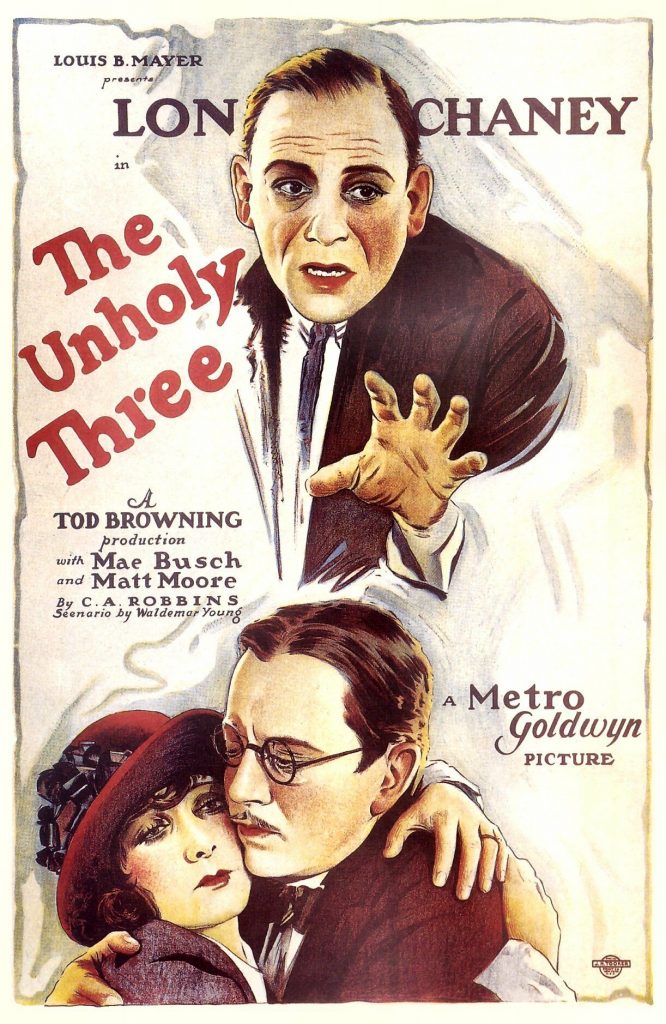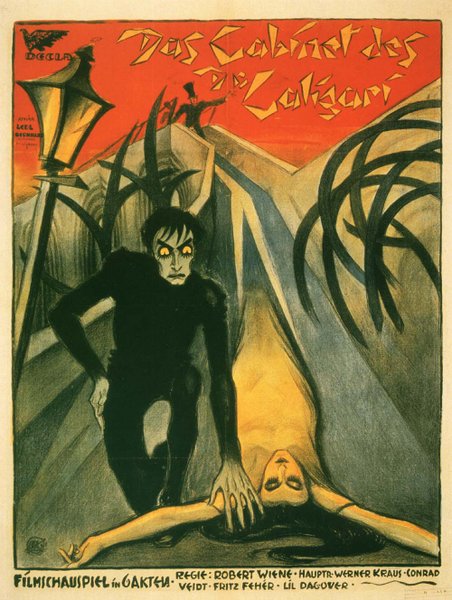
In The Unholy Three, Tod Browning directs Lon Chaney in a dark crime film.
By Scott A. Cupp
This is the 189th in my series of Forgotten, Obscure or Neglected Films
Sometimes, I have previously seen the films that I decide to review. Others, I see them for the first time with the idea of writing about them. This week is one of the latter. I became aware of Long Chaney’s work when I saw the film Man of a Thousand Faces with James Cagney, which was a fascinating biographical film. And I initially saw the work of his son, Lon Chaney Jr. in a wonderful series of Universal horror films.
In college, I got to see my first Lon Chaney film, The Phantom of the Opera. What a thrill! I witnessed the wonderful acting, the various stylized movements that he used, the pathos and the horror.
But I never saw any of his others. I recorded several but erased them when I began to run out of space. Silent films take a dedication from the viewer. Watching a talking film allows you to multitask. You can listen to the dialogue while checking email and not necessarily miss much. But silent films require your full attention. You never know when a card is going to appear explaining something essential. And you cannot be assured you’ll catch all the action when there are no loud explosions or screeching tires to draw your attention to the screen.
All that said, I sat back on a Sunday afternoon to watch a classic Chaney film, The Unholy Three. I knew it was one of his big roles so I was ready. At 84 minutes, I could give it all of my attention and still not require the entire afternoon to watch and digest.
Ventriloquist Professor Echo (Chaney) works at a sideshow with several memorable characters. There are the Fat Lady, the Tattooed Lady, Hercules (Victor McLaglen), the diminutive Tweedledee (Harry Earles) and others. Sweet Rosie O’Grady (Mae Busch) works the crowds as a pickpocket. Their lives all get unsettled when Tweedledee gets into a fight with an unruly spectator kid. The ensuing riot ends with them leaving the sideshow.
Echo suggests an alliance between himself, Hercules, and Tweedledee. “We will make millions!” he tells them. They laugh together and Tweedledee proposes the name the Unholy Three.
The next scene shows Rosie entering O’Grady’s Bird Shop, where she greets clerk Hector McDonald (Matt Moore) who sells parrots at the store. Rosie flirts with him. They are interrupted by her grandmother and the infant Little Willie. But things are not as they appear. Grandmother O’Grady is Chaney and Little Willie is Tweedledee. They have a scheme going. Hector sells talking parrots but they really talk for Mrs. O’Grady.
When the birds are delivered, they don’t really talk in the homes of their owners. Mrs. O’Grady goes to visit the homes and case the joints. She brings the pram with the baby inside and he helps in the casing.
One such visit takes place on Christmas Eve at the Arlington home. Grandmother and baby see a wonderful ruby necklace which they prepare to steal that evening. As they make their plans, Rosie comes to visit, but she runs into Hector carrying a tree and ornaments to set up for Little Willie. Grandmother is jealous of Hector and Rosie (since Rosie is his girl). With Echo trapped, Hercules and Tweedledee go on without him to carry out the robbery. Things do not go well and Mr. Arlington is murdered.
Police begin to suspect the grandmother, so Echo sets up Hector to be the fall guy. But Rosie has fallen in love. And the unholy trio has some dissention in their ranks. Thoughts that the loot might be better split by two, or not even split at all, run through their minds.
Bad things happen, some at the hands of a killer ape! My type of film!
I liked this Tod Browning-directed piece quite a lot, though TCM had a film score appended that intruded more often than not. In fact, I just hated the music. It’s a pretty dark film and the ending lacks some believability. But, despite those quibbles, I would watch it again in a heartbeat. Chaney is remarkable. Harry Earles tries to steal every scene, and I had to admire his effort, even though I hated his character.
If you can read your films (and many folks I know can’t. I’m looking at my wife as I type this. She’s one of them!), this is one you should see.
Series organizer Todd Mason host Tuesday Forgotten Film reviews at his own blog and posts a complete list of participating blogs.

